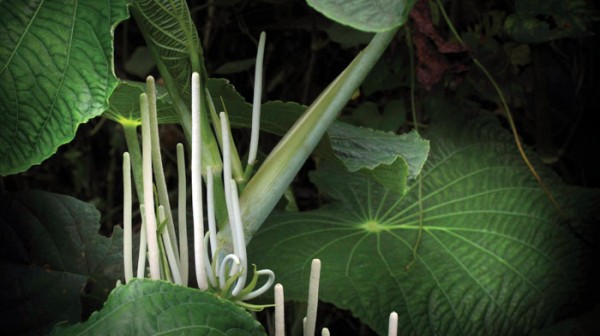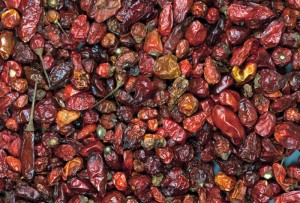PEPPER(S)
Piper species — “Pepper” (as in “salt & pepper”) and Chili “Peppers”
Written by. Dr. Nicholas M. Hellmuth
Our salt-and-pepper pepper is Piper nigrum, which originated in India. There are actually three completely different kinds of native plants in Guatemala named “pepper” (or pimienta): pepper leaf (flavoring from leaf, seed or flower stick), pepper vegetables and pepper spice (flavoring from seed or tea from leaf).
Of course the Classic Maya never used the word “pepper” or “pimiento,” the original Maya had their own nomenclature. It is the misunderstanding and confusion of the conquering Spanish (and one botanist) who dumped the name “pimienta” (from the black pepper of India) on all three totally unrelated plants in Guatemala and Mexico.
The Classic Maya 1,000 years ago, and the modern Maya descendants today, still use spices: for food and for the deities. As well, allspice, (also referred to as pimienta gorda, pimenta dioica) is native to Mesoamerica; you will see it everywhere at Tikal or around Lake Yaxhá and in most mature forests in Alta Verapaz, Petén and Izabal. Allspice is one single spice; it is not a mixture of diverse plants. It was named allspice because its flavor brings to mind many different separate spices. The most common use in rural areas is to make tea from the leaves.
Chili peppers are part of the nightshade family (Solanaceae), which produces the edible tomato, potato, plus the several addictive tobacco species, and the rather dangerous nightshade plants. You can find diverse varieties of chili peppers in the markets of La Antigua and most cities around Guatemala. Ask for, and enjoy eating, chili chocolate.
Although I have been drinking tea from pimienta gorda since I was young, I did not know about Piper auritum, (Spanish name, Hoja santa) until a Universidad del Valle biology student, Daniela da’Costa, explained it to me. Actually it turns out we have one growing in our interior patio in the FLAAR office garden (as was identified by Priscila Sandoval, biologist graduating from USAC). Piper auritum was once a source of sassafras flavoring for root beer. But the leaves of P. auritum have high contents in safrol, the active compound that is carcinogenic.
Interestingly, most of the Piper species are commonly used as native medicines throughout Mesoamerica. Plus, whether Piper is carcinogenic to humans is evidently debated.
So, although Christopher Columbus did not find a direct route to India for the first few years, since their voyages were funded to find a route for black pepper from India, they cleverly came back with at least “pepper.” So now you know why chili is called pepper. Now you know why Piper auritum is called pepper. We can’t blame the word “allspice” on Christopher Columbus, but as long as we are discussing “pimienta” I thought I would include it as a comment: the scientific name is Pimenta dioica.
web sites for Piper species www.uni-graz.at/~katzer/engl/Pipe_aur.html www.rain-tree.com/matico.htm
www.tlahui.com/medic/medic29/hoja_santa.htm www.maya-ethnobotany.org. web sites for chili peppers:
www.g6csy.net/chile/var-p.htmlDr. Nicholas M. Hellmuth is director of FLAAR Reports (Foundation for Latin American Anthropological Research). For a bibliography from this article and other information, you may contact Dr. Hellmuth and his staff by email: FrontDesk@FLAAR.org

